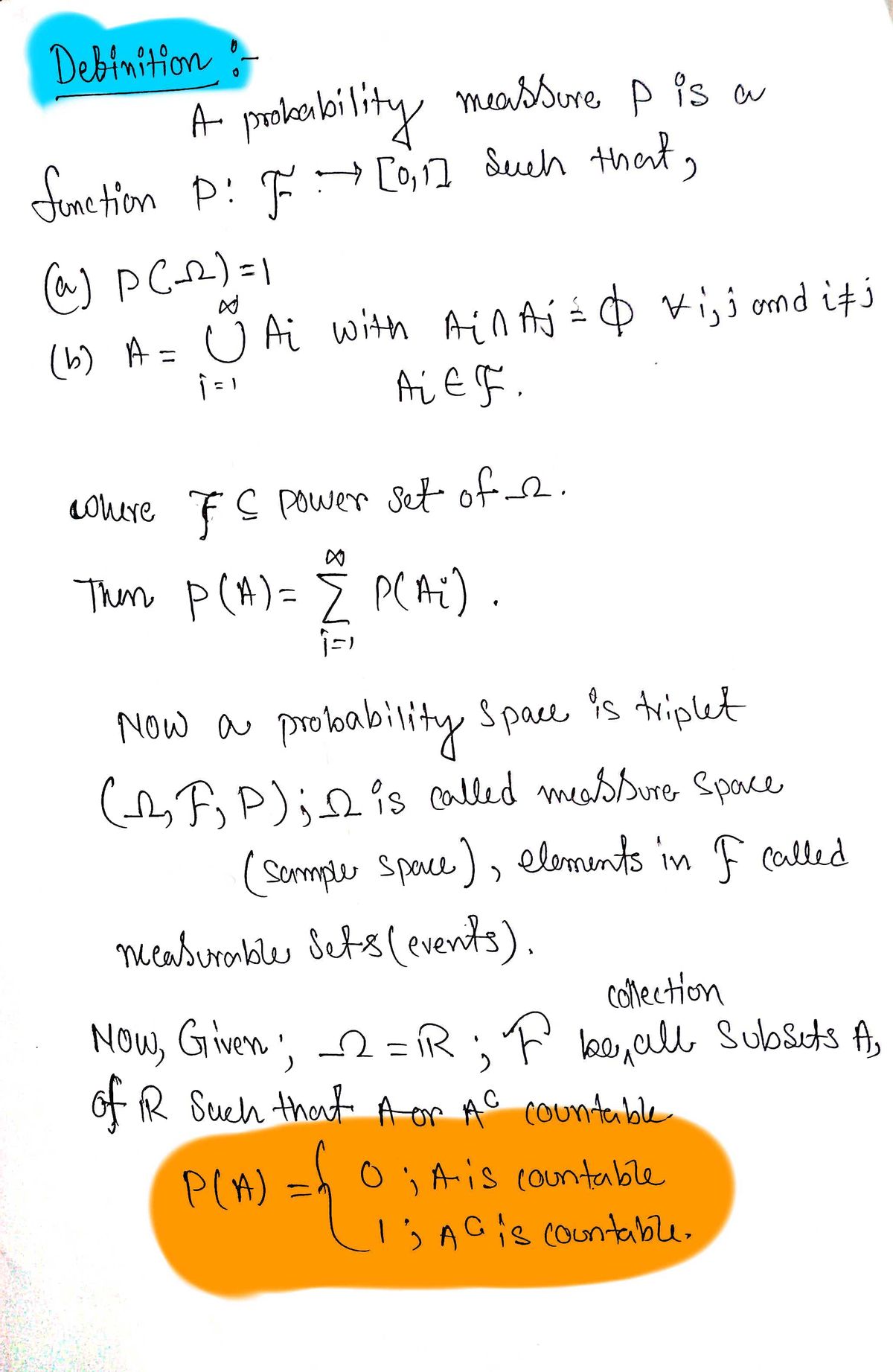Let N = R, and F be all subsets so that A or A is countable. Also, let J0, A is countable |1, A° is countable P(A) = Show that (2, F, P) is a probability space.
Let N = R, and F be all subsets so that A or A is countable. Also, let J0, A is countable |1, A° is countable P(A) = Show that (2, F, P) is a probability space.
Advanced Engineering Mathematics
10th Edition
ISBN:9780470458365
Author:Erwin Kreyszig
Publisher:Erwin Kreyszig
Chapter2: Second-order Linear Odes
Section: Chapter Questions
Problem 1RQ
Related questions
Question
![**Problem Statement:**
Let \(\Omega = \mathbb{R}\), and \(\mathcal{F}\) be all subsets such that \(A\) or \(A^c\) is countable. Also, let
\[
P(A) =
\begin{cases}
0, & \text{if } A \text{ is countable} \\
1, & \text{if } A^c \text{ is countable}
\end{cases}.
\]
**Task:**
Show that \((\Omega, \mathcal{F}, P)\) is a probability space.
**Explanation:**
In this problem, we are defining a probability space over the real numbers \(\mathbb{R}\).
1. **Sample Space (\(\Omega\)):** The set of all real numbers, \(\mathbb{R}\).
2. **Sigma-algebra (\(\mathcal{F}\)):** A collection of subsets of \(\mathbb{R}\) such that for every set \(A\) in \(\mathcal{F}\), either \(A\) itself or its complement \(A^c\) is countable.
3. **Probability Measure (P):** A function \(P: \mathcal{F} \to [0,1]\) defined by:
- \(P(A) = 0\) if the subset \(A\) is countable.
- \(P(A) = 1\) if the complement \(A^c\) is countable.
The task is to demonstrate that these three components together satisfy the axioms of a probability space.](/v2/_next/image?url=https%3A%2F%2Fcontent.bartleby.com%2Fqna-images%2Fquestion%2F833481a2-df8c-4805-95a2-f24b64ba619f%2Fa71898c1-c32e-4243-84f6-363ca9bb2e5a%2Fxhdabk7_processed.jpeg&w=3840&q=75)
Transcribed Image Text:**Problem Statement:**
Let \(\Omega = \mathbb{R}\), and \(\mathcal{F}\) be all subsets such that \(A\) or \(A^c\) is countable. Also, let
\[
P(A) =
\begin{cases}
0, & \text{if } A \text{ is countable} \\
1, & \text{if } A^c \text{ is countable}
\end{cases}.
\]
**Task:**
Show that \((\Omega, \mathcal{F}, P)\) is a probability space.
**Explanation:**
In this problem, we are defining a probability space over the real numbers \(\mathbb{R}\).
1. **Sample Space (\(\Omega\)):** The set of all real numbers, \(\mathbb{R}\).
2. **Sigma-algebra (\(\mathcal{F}\)):** A collection of subsets of \(\mathbb{R}\) such that for every set \(A\) in \(\mathcal{F}\), either \(A\) itself or its complement \(A^c\) is countable.
3. **Probability Measure (P):** A function \(P: \mathcal{F} \to [0,1]\) defined by:
- \(P(A) = 0\) if the subset \(A\) is countable.
- \(P(A) = 1\) if the complement \(A^c\) is countable.
The task is to demonstrate that these three components together satisfy the axioms of a probability space.
Expert Solution
Step 1

Trending now
This is a popular solution!
Step by step
Solved in 3 steps with 3 images

Recommended textbooks for you

Advanced Engineering Mathematics
Advanced Math
ISBN:
9780470458365
Author:
Erwin Kreyszig
Publisher:
Wiley, John & Sons, Incorporated

Numerical Methods for Engineers
Advanced Math
ISBN:
9780073397924
Author:
Steven C. Chapra Dr., Raymond P. Canale
Publisher:
McGraw-Hill Education

Introductory Mathematics for Engineering Applicat…
Advanced Math
ISBN:
9781118141809
Author:
Nathan Klingbeil
Publisher:
WILEY

Advanced Engineering Mathematics
Advanced Math
ISBN:
9780470458365
Author:
Erwin Kreyszig
Publisher:
Wiley, John & Sons, Incorporated

Numerical Methods for Engineers
Advanced Math
ISBN:
9780073397924
Author:
Steven C. Chapra Dr., Raymond P. Canale
Publisher:
McGraw-Hill Education

Introductory Mathematics for Engineering Applicat…
Advanced Math
ISBN:
9781118141809
Author:
Nathan Klingbeil
Publisher:
WILEY

Mathematics For Machine Technology
Advanced Math
ISBN:
9781337798310
Author:
Peterson, John.
Publisher:
Cengage Learning,

